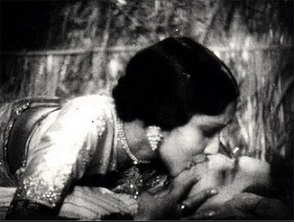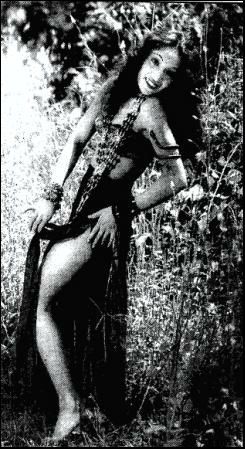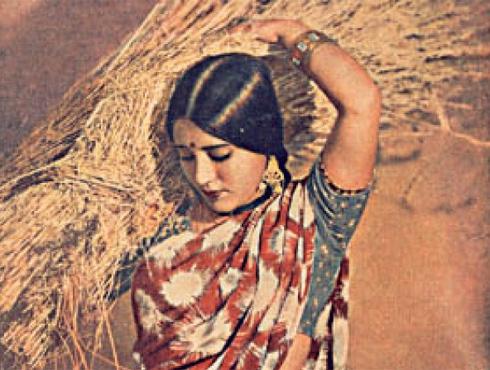Indian cinema: 1930-39
Contents |
Indian cinema: 1930-39
Title and authorship of the original article(s)
|
Brief history of Indian cinema By UrooJ, aligarians.com, mid-2000 |
Bollywood Cinema By h2g2, mid-2000 |
This is an article selected for the excellence of its content. |
1930
The thirties are recognised as the decade of social protests in the history of Indian Cinema. Three big banners-Prabhat, Bombay Talkies and New Theatres gave the lead in making serious but gripping sand entertaining films for all classes of the wide audience. A number of films making a strong plea against social injustice were also made in this period like V.Santharam's Duniya Na Mane, Aadmi and Padosi, Franz Osten's Achut Kanya, Damle & Fatehlal's Sant Thukaram, Mehboob's Watan, Ek hi Raasta and Aurat. For the first time Ardeshir Irani attempted a colour picture in 1937 with Kisan Kanya
The decade also witnessed the release of the first talkie films in Marathi (Ayodhiyecha Raja 1932), Gujarathi (Narasinh Mehta-32), Kannada (Dhurvkumar-34); Oriya (Sita Bibaha-34); Assamese (Joymati-35); Punjabi (Sheila-35) and Malayalam(Balan-38).
An early talkie, Madan Theatres' Indrasabha (1932) showed leggy dances, which were like today's item numbers.
The 1930s heroine Lalita Pawar, who acted in Himmat-e-Marda (1935) was christened the Indian Greta Garbo.
1930 : Sailajananda Mukherjee starts the Bengali film weekly Bioscope reporting on the Hollywood, Bombay and Calcutta film industries and publishing reviews, pre-release synopses of films, industrial surveys and occasionally essays about technical and aesthetic issues. Ambalal Patel and Chimanlal Desai start Sagar Film. Gubbi Veeranna starts production with the Gubbi-Karnataka Films Corporation at the Malleshwaram Studios in Bangalore. First Film society in India known as Punjab Cinema Art Society.
1931: a landmark year
Alam Ara (1931) was the genesis of the talkie feature films. The film's popular Hindustani dialogues and seven songs made it a big hit which resulted in other filmmakers to raise the number of songs in their films till it reached a whooping 71 in "Indrasabha". Film songs became a Pan-Indian phenomenon.
The most remarkable things about the birth of the sound film in India is that it came with a bang and quickly displaced the silent movies. The first Indian talkie Alam Ara produced by the Imperial film company and directed by Ardershir Irani was released on March 14, 1931 at the Majestic Cinema in Bombay; The talkie had brought revolutionary changes in the whole set up of the industry. The year 1931 marked the beginning of the talking ear in Bengal and South India.
The first talkie films in Bengali (Jumai Shasthi), Telugu (Bhakta Prahlad) and Tamil (Kalidass) were released in the same year.
In 1931, just as the 'talkie revolution' was happening in Indian films, well-known silent actress Sultana filed a case in the Bombay High Court claiming to be the lawful wife of YH Laljee, son of the ex-head of the Bombay Municipal Corporation, and claimed rupees five lakh, a princely sum at the time. Before Sultana, silent actress Ermeline had filed a case in 1927 against Chaturbhai Patel, cameraman of Shri Krishna Film Company, where she was employed, for attempting to 'outrage her modesty'. TOI described the episode as 'a sensational case which has a direct bearing on the future of the Indian cinema industry...'.
An actor today might discover her career compromised as a fallout of controversy, but Ermeline went on to appear in more films, and became a star in the later 1920s.
1931 : Alam Ara is India’s first sound film. B.N. Sircar founds New Theatres. Several Madan Theatres productions follow in quick successions with vastly superior sound systems. Pancholi’s Empire Talkie Distributors acquires rights to RKO - Radio productions and RCA - Photophone sound equipment. The Bengali film weeklies Chitralekha and Batayan and literary quarterly Parichay start.
1932 : First sound feature in Gujarati (Narasinh Mehta). The East India film Co. starts in Calcutta pioneering Bengali, Tamil and Telegu filmmaking. The Motion Picture Society of India (MPSI) is set up to represent the Indian Film Industry. Hindi weekly Cinema Sansar launched in Bombay. In Bengal the monthly Chitrapanji includes serious essays by filmmakers.
1933 : Prabhat Studio moves to Pune. Its Sairandhri processed and printed in Germany becomes India’s first colour film. Kolhapur Cinetone is started. Wadia Movietone is founded. Vijay Bhatt and others start Prakash Pictures. Vel Pictures and Tamil Nadu talkies are launched in Madras. Himanshu Rai’s Karma is premiered in London. The air - conditioned Regal cinema opens in Bombay.
1934 : Bombay Talkies is established by Himansu Rai and Devika Rani. East India Film Company’s Seeta directed by Debaki Bose is shown at Venice Film Festival. First sound features in Oriya (Seeta Bibaha) and Kannada (Bhakta Dhruva). Seeta Kalyanam made by Vel Pictures is the first sound feature made in Madras. Ranjit Studio’s Toofan Mail is the Hindi Cinema’s first major success in the stunt film genre. Hindi film periodical Chitrapat is launched in Delhi. Bengali film weekly Ruprekha starts.
1935 : First All-India Motion Picture Convention is held. New Theatres Devdas directed by P.C. Barua becomes reference point in Hindi and Bengali Cinema. New Theatres’ Dhoop Chaon establishes playback singing. Launch of the seminal film monthly Filmindia. The Quetta earthquake takes place on May 21. Its after effects are filmed by P.V. Pathy. First films in Punjabi (Sheila) and Assamese (Joymati). Madras United Artisits started at Salem. First Trade journal started by Motion Picture Society of India.
1936 : Amar Jyoti is shown in Venice. Master Vinayak and cameraman Pandurang Naik co-found Huns Pictures. Jaddanbai starts Sangeet Films with films featuring her daughter Nargis as a child artiste. Sohrab Modi and Rustom Modi start Minerva Movietone. The Bengal Motion Picture Association is formed in Calcutta. The second All-India Motion Picture Convention held at Madras. Ardershir Irani sets up cinecolour process laboratory with Wolf M. Henius as chief technician.
1937 : Indian Motion Picture Producers Association (IMPPA) founded in Bombay. Sant Tukaram receives special jury mention at Venice Film Festival. Imperial Film Company releases colour film Kisan Kanya using Cinecolour process. First songless film - J.B.H. Wadia’s Naujawan. The Amateur Cine Society of India formed in Bombay by P.V. Pathy, Stanley Jepson and Rudi Van Leyden. Bengali Film weekly Kheyali founded.
1938 : South Indian Film Chamber of Commerce formed in Madras. Indian Motion Picture Distributors Association set up in Bombay. Duniya Na Mane ( 1937) shown in Venice. Bombay Talkies makes probably the first officially commissioned ad film on Lever’s Dalda cooking oil for the Lintas Advertising Agency. The first Malayalam sound film, Balan. The Indian Screen Gazette is started by Wadia Movietone. P.V. Pathy films a three-reeler on the Haripura Congres for the Gazette.
1939 : Indian Film Industry celebrates its silver jubilee and holds Indian Motion Picture Congres in Bombay bringing together allied unions and trade associations to discuss problems. Vauhuni Pictures is started by B.N. Reddy and Gemini by S.S. Vasan. Film Industry, a trade newspaper is started in Bombay.
Hindi-Urdu films
1930 Ram Rahim E. Bilimoria Veer Na Ver Moti B. Gidwani Gohar
1931 Alam Ara Ardeshir Irani Master Vithal First ever Hindi film with sound
Ghar Ki Lakshmi
1932
Ayodhya
1933
Lal-e-Yamen
1934
Bombai Ki Mohini
Char Dervesh
Daku Ki Ladki
Miss 1933
Nai Duniya
1935
Aadmi Aur Padosi
Aurat
Ek Hi Raasta
Hunter Wali
Sairandhri
Watan
1936
Achhut Kanya Franz Osten Ashok Kumar, Devika Rani Deals with social position of the Dalit Produced by Himanshu Rai
Devdas P.C. Barua Based on Sharat Chandra Chattopadhyay’s novel
Mamta
Mr. & Mrs. Bombay
Jeevan Naiya Franz Osten Ashok Kumar, Devika Rani
1937 Duniya Na Mane V. Shantaram Shanta Apte, Keshavrao Date Social classic Prabhat Film Company
Kisan Kanya Moti B. Gidvani Padmadevi, Jillo India's first indigenously made colour film.
Naujawan
Parakh
The President Nitin Bose Kundan Lal Saigal
Zameen Ka Chand
1938 Adhikar
Bhabhi
1939 Leatherface
Prem Sagar
Pukar Chandra Mohan,Naseem Bano,Sohrab Modi|
Kannada films
Year/ Movie (in Kannada)/ Director/ Cast/ Music Director/ Producer/ Banner
1934 Sati Sulochana (ಸತಿ ಸುಲೋಚನ) Y. V. Rao Nagendrarao, Subbaiah Naidu, Lakshmi Bai, Tripuraamba, C.T.Sheshachalam R.Nagendra rao Sha Chamanlal Dungaji South India Movitone
1934 Bhakta Dhruva (ಭಕ್ತ ಧೃವ) Paarshvanathah Aaltekar Master Muthu, T.Dwarakanath, H.S.Krishnaswamy Iyengar, G.Nageshrayaru, M.G.Marirao, T.Kanakalakshmama Harmonium Sheshagirirao Dr.Y.L. Narayana Rao Jayavani Talkies
1935 Sadaarame (ಸದಾರಮೆ) Rajaa Chandrashekar Gubbi Veeranna, Muraaraachaar, Shakunthala, K.Ashawathamma, Swaranamma Venkataramaiah (Papanna) Gubbi Veeranna Shakunthala Films
1936 Samsara Nauka (ಸಂಸಾರ ನೌಕ) H.L.N.Simha B.R.Panthulu, M.V.Rajamma, S.K.Padma Devi, M.S.Madhavarao, Dikki Madavarao M.Madhavarao K.Nanjappa Devi Films T.Telangi
1936 Chiranjeeve (ಚಿರಂಜೀವಿ) K.P.Bhave Devudu, Sharada, Malavalli Sundaramma, Basavaraju Mansoor, R.S.Murthy, Narayanarao Harmonium Sheshagirirao Kyanarees Talkies
1937 Purandaradaasa (ಪುರಂದರದಾಸ) B.Chawan G.Krishnaswamy Iyengar, Tripuraamba, J.T. Balakrishnarao, Devi Films
1937 Rajasuya Yaaga (ರಾಜಸೂಯ ಯಾಗ) T.Dwarakanath S.R.Vasudevarao, T.K.Ramamurhty, K.R.Seetharam, T.Jayamma, T.Chandrashekar, Saroja Padmanabha shashtri Mysore Sound Studios
Malayalam films
Year/ Movie/ Director/ Cast/ Music Director/ Producer/ Banner
Marthanda Varma 1933 P. V. Rao C. V. Raman Pillai
Balan 1938 S. Nottani Sundaram Pillai A Muthukulam Raghavan Pillai K. K. Aroor, Alleppey Vincent, M. K. Kamalam
Indian cinema: historical outline Covers the era before the first Indian feature film
Indian cinema: 1930-39
Indian cinema: 2010-19

